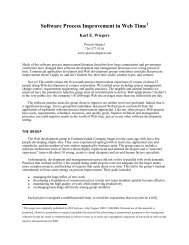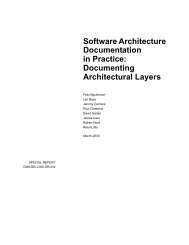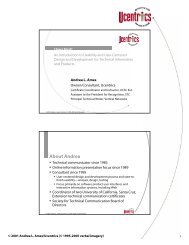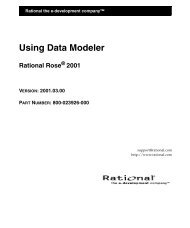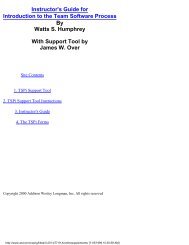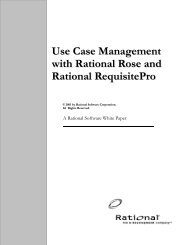RSI - A Structured Approach Use Cases and HCI Design
RSI - A Structured Approach Use Cases and HCI Design
RSI - A Structured Approach Use Cases and HCI Design
Create successful ePaper yourself
Turn your PDF publications into a flip-book with our unique Google optimized e-Paper software.
The <strong>RSI</strong> <strong>Approach</strong> To <strong>HCI</strong> <strong>Design</strong> / <strong>Use</strong> Case Analysis Page 6 of 42<br />
– functions to create new customers <strong>and</strong> accounts, <strong>and</strong><br />
– functions to produce a monthly overdraft report<br />
• interaction flows (double ended arrows), showing which actors interact with which use<br />
cases.<br />
<strong>Use</strong> case diagrams are typically supplemented with additional documentation, describing the<br />
detail of each use case.<br />
Jacobson's use cases are structured around business processes for which automated support is<br />
required. Page 350, section 13.3.1 of Object Oriented Software Engineering [1] describes the<br />
use case 'Transfer goods between warehouses'. The description of this use case contains both<br />
individual 'comm<strong>and</strong>s' ("Foreman issues comm<strong>and</strong> to transfer goods between warehouses",<br />
"Truck driver notifies system that he has arrived at the warehouse", etc.), <strong>and</strong> detailed user<br />
interface designs (diagrams of dialogs are shown). Much of the description is concerned with<br />
describing user interface dynamics (e.g. "the foreman may move between fields by using the<br />
tab key.").<br />
Jacobson introduced two relationships between use cases: «uses» <strong>and</strong> «extends». As the<br />
semantics of these relationships has now been superseded by the UML 1.3 specification<br />
further discussion of use case inter-relationships is left until later.<br />
1.2. Goal oriented use case analysis - Alistair Cockburn<br />
Cockburn's work ("Structuring <strong>Use</strong> <strong>Cases</strong> with Goals" [2]) recognised that use cases had<br />
"improved the situation that requirements documents [are] often an arbitrary collection of<br />
paragraphs, having a poor fit with both business re-engineering <strong>and</strong> implementation." He<br />
noted, however, that he had personally encountered 18 different definitions of use cases given<br />
by different, but expert teachers <strong>and</strong> consultants.<br />
To remedy this, Cockburn went on to describe a goal-oriented approach to use case analysis,<br />
in which a use case is described in terms of a goal oriented sequence of business or work<br />
steps. The following use case extract is taken from Cockburn's paper [2]:<br />
<strong>Use</strong> case: get paid for car accident (insurance system):<br />
Actor - Claimant<br />
Actor goal - to get paid for a car accident<br />
1. Claimant submits claim with substantiating data;<br />
2. Insurance company verifies claimant owns a valid policy<br />
3. Insurance company assigns agent to examine case<br />
4. Agent verifies all details are within policy guidelines<br />
5. Insurance company pays claimant<br />
Extensions<br />
W5a - <strong>RSI</strong> LONG PAPER [42 PAGES].doc( Rev: 5) - 03/09/00



